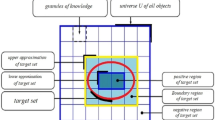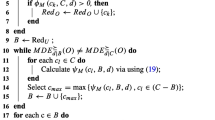Abstract
A decision theoretic rough set-based neighborhood selection process is developed for self-organizing maps. While the neighborhood of the winner neuron is selected based on the probability of its associativity to the winner neuron, the selected neighborhood is updated using a new method which combines the probability of its associativity and the Gaussian function. This approach provides better results as compared to self-organizing map and other clustering algorithms on several real-life datasets. The results are evaluated in terms of DB index, Dunn index, quantization error, ARI, and NMI.





Similar content being viewed by others
References
Alon U, Barkai N, Notterman DA, Gish K, Ybarra S, Mack D, Levine AJ. Broad patterns of gene expression revealed by clustering analysis of tumor and normal colon tissues probed by oligonucleotide arrays. Proc Natl Acad Sci USA. 1999;96:6745–50.
Bednar JA, Kelkar A, Miikkulainen R. Modeling large cortical networks with growing self-organizing maps. Neurocomputing. 2002;44–46:315–21.
Boyle JO, Gümü ZH, Kacker A, Choksi VL, Jennifer M, Zhou XK, Yantiss RK, Hughes DB, Du B, Judson L, Subbaramaiah K, Dannenberg AJ. Effects of cigarette smoke on the human oral mucosal transcriptome. NIH Public Access. 2011;3:266–78.
Braga PH, Bassani HF. A semi-supervised self-organizing map for clustering and classification. In: 2018 international joint conference on neural networks (IJCNN). IEEE; 2018. p. 1–8.
Chiang J-H, Ho S-H. A combination of rough-based feature selection and rbf neural network for classification using gene expression data. IEEE Trans Nanobiosci. 2008;7(1):91–9.
Collignon A. Multi-modality medical image registration by maximization of mutual information. 1998.
Davies DL, Bouldin DW. A cluster separation measure. IEEE Trans Pattern Anal Mach Intell. 1979;1:224–7.
Dunn JC. A fuzzy relative of the isodata process and its use in detecting compact well-separated clusters. J Cybern. 1973;3:32–57.
Ester M, Kriegel H-P, Sander J, Xu X. A density-based algorithm for discovering clusters a density-based algorithm for discovering clusters in large spatial databases with noise. In: Proceedings of the second international conference on knowledge discovery and data mining, KDD’96. AAAI Press; 1996. p. 226–231.
Golub TR, Slonim DK, Tamayo P, Huard C, Gaasenbeek M, Mesirov JP, Coller H, Loh ML, Downing JR, Caligiuri MA, Bloomfield CD, Lander ES. Molecular classification of cancer: class discovery and class prediction by gene expression monitoring. Science. 1999;286:531–7.
Gorzałczany MB, Rudziński F. Generalized self-organizing maps for automatic determination of the number of clusters and their multiprototypes in cluster analysis. IEEE Trans Neural Netw Learn Syst. 2017;29(7):2833–45.
Greco S, Matarazzo B, Słowiński R. Parameterized rough set model using rough membership and Bayesian confirmation measures. Int J Approx Reason. 2008;49(2):285–300.
Hébert P-A, Masson M-H, Denoeux T. Fuzzy multidimensional scaling. Comput Stat Data Anal. 2006;51(1):335–59.
Kamimura R. Cooperative information maximization with gaussian activation functions for self-organizing maps. IEEE Trans Neural Netw. 2006;17(4):909–18.
Kohonen T. Self-organized formation of topologically correct feature maps. Biol Cybern. 1982;43:59–69.
Kong EC, Allouche L, Chapot PA, Vranizan K, Moore MS, Wolf FW. Ethanol-regulated genes that contribute to ethanol sensitivity and rapid tolerance in drosophila. NIH Public Access. 2010;34:302–16.
Kostiainen T, Lampinen J. Self-organizing map as a probability density model. In: IJCNN’01. International joint conference on neural networks. Proceedings (Cat. No. 01CH37222), vol. 1. IEEE; 2001. p. 394–399.
Labroche N. New incremental fuzzy c medoids clustering algorithms. In: North American fuzzy information processing society (NAFIPS). 2010. p. 1–6.
Lampinen J, Oja E. Clustering properties of hierarchical self-organizing maps. J Math Imaging Vis. 1992;2:261–72.
Li F, Ye M, Chen X. An extension to rough c-means clustering based on decision-theoretic rough sets model. Int J Approx Reason. 2014;55:116–29.
Li Y, Fan J-C, Pan J-S, Mao G-H, Wu G-K. A novel rough fuzzy clustering algorithm with a new similarity measurement. J Internet Technol. 2019;20(4):1145–56.
Maji P, Pal S. Rough set based generalized fuzzy c-means algorithm and quantitative indices. IEEE Trans Syst Man Cybern Part B. 2007;37:1529–40.
Maji P, Paul S. Robust rough-fuzzy c-means algorithm: design and applications in coding and non-coding rna expression data clustering. Fundam Inform. 2013;124:153–74.
Na S, Xumin L, Yong G. Research on k-means clustering algorithm: an improved k-means clustering algorithm. In: Intelligent information technology and security informatics (IITSI). 2010. p. 63–67.
Papliński AP, Gustafsson L. Multimodal feedforward self-organizing maps. Berlin: Springer; 2005. p. 81–88.
Pawlak Z. Rough set theory and its applications. J Telecommun Inf Technol. 1998;29:7–10.
Ramos AD, López-Rubio E, Palomo EJ. The forbidden region self-organizing map neural network. IEEE Trans Neural Netw Learn Syst. 2019;31(1):201–11.
Ray SS, Ganivada A, Pal S. A granular self-organizing map for clustering and gene selection in microarray data. IEEE Trans Neural Netw (online). 2015. p. 1–17.
Ray SS, Misra S. A supervised weighted similarity measure for gene expressions using biological knowledge. Gene. 2016;595(2):150–60.
Rokach L, Maimon O. Clustering methods. Springer US; 2005. p. 321–352.
Sarkar M, Yegnanarayana B. Fuzzy-rough membership functions. IEEE Int Conf Syst Man Cybern. 1998;2:2028–33.
Singh D, Febbo PG, Ross K, Jackson DG, Manola J, Ladd C, Tamayo P, Renshaw AA, D’Amico AV, Richie JP, Lander ES, Loda M, Kantoff PW, Golub TR, Sellers WR. Gene expression correlates of clinical prostate cancer behaviour. Cancer Cell. 2002;1:203–9.
Sun Y. On quantization error of self-organizing map network. Neurocomputing. 2000;34(1–4):169–93.
Wu X, Wang JJ, Cui XX, Maianu LL, Rhees BB, Rosinski JJ, So WVWV, Willi SMSM, Osier MV, Hill HS, Page GP, Allison DB, Martin M, Garvey WT. The effect of insulin on expression of genes and biochemical pathways in human skeletal muscle. Endocrine. 2007;31(1):5–17.
Xu R, Wunsch D. Survey of clustering algorithms for manet. IEEE Trans Neural Netw. 2005;16:645–78.
Yao Y. Decision-theoretic rough set models. Proc Rough Sets Knowl Technol. 2007;4481:1–12.
Yao Y. Probabilistic rough set approximations. Int J Approx Reason. 2008;49:255–71.
Yao YY. Probabilistic approaches to rough sets. Expert Syst. 2003;20:287–97.
Yeung KY, Ruzzo WL. Details of the adjusted rand index and clustering algorithms, supplement to the paper an empirical study on principal component analysis for clustering gene expression data. Bioinformatics. 2001;17(9):763–74.
Zadeh A. Towards a theory of fuzzy information granulation and its centrality in human reasoning and fuzzy logic. Fuzzy Sets Syst. 1997;90:111–27.
Zhang S, Ge S. User power interaction behavior clustering analysis that is based on the self-organizing-center k-means algorithm. IEEE Access. 2019;7:175879–888.
Ziarko W. Variable precision rough set model. J Comput Syst Sci. 1993;46:39–59.
Acknowledgements
Sudip Ghosh acknowledges the financial assistance provided by Department of Science and Technology.
Author information
Authors and Affiliations
Corresponding author
Ethics declarations
Conflict of interest
The authors declare that they have no conflict of interest.
Additional information
Publisher's Note
Springer Nature remains neutral with regard to jurisdictional claims in published maps and institutional affiliations.
Rights and permissions
About this article
Cite this article
Ray, S.S., Agrawal, S. & Ghosh, S. Decision Theoretic Rough Set-Based Neighborhood for Self-Organizing Map. SN COMPUT. SCI. 2, 102 (2021). https://doi.org/10.1007/s42979-021-00490-2
Received:
Accepted:
Published:
DOI: https://doi.org/10.1007/s42979-021-00490-2




